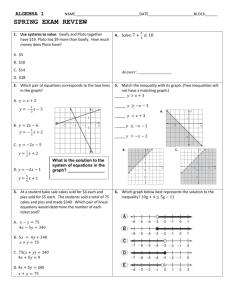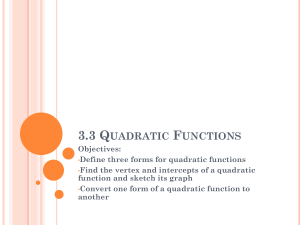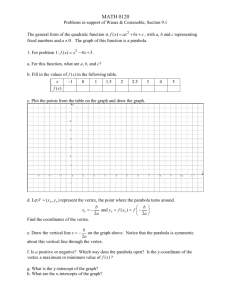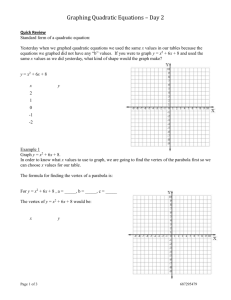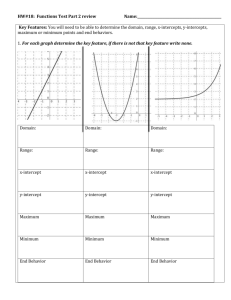Building Polynomial Functions Worksheet
advertisement
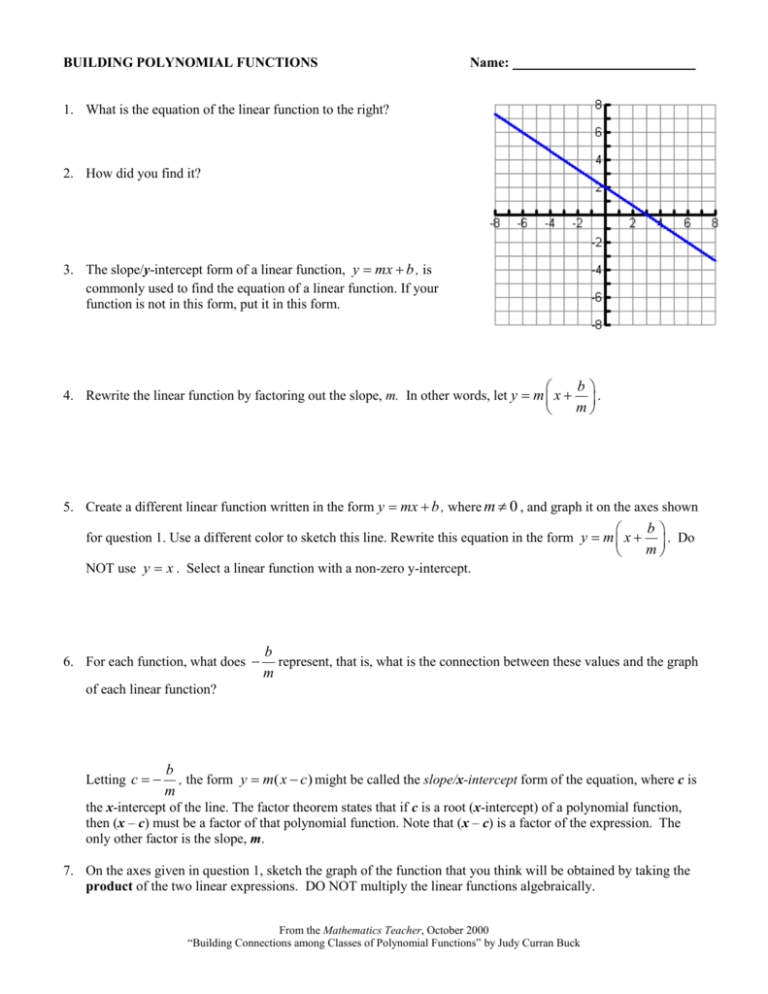
BUILDING POLYNOMIAL FUNCTIONS Name: 1. What is the equation of the linear function to the right? 2. How did you find it? 3. The slope/y-intercept form of a linear function, y mx b , is commonly used to find the equation of a linear function. If your function is not in this form, put it in this form. 4. Rewrite the linear function by factoring out the slope, m. In other words, let y m x b . m 5. Create a different linear function written in the form y mx b , where m 0 , and graph it on the axes shown for question 1. Use a different color to sketch this line. Rewrite this equation in the form y m x NOT use y x . Select a linear function with a non-zero y-intercept. 6. For each function, what does b . Do m b represent, that is, what is the connection between these values and the graph m of each linear function? Letting c b , the form y m( x c ) might be called the slope/x-intercept form of the equation, where c is m the x-intercept of the line. The factor theorem states that if c is a root (x-intercept) of a polynomial function, then (x – c) must be a factor of that polynomial function. Note that (x – c) is a factor of the expression. The only other factor is the slope, m. 7. On the axes given in question 1, sketch the graph of the function that you think will be obtained by taking the product of the two linear expressions. DO NOT multiply the linear functions algebraically. From the Mathematics Teacher, October 2000 “Building Connections among Classes of Polynomial Functions” by Judy Curran Buck 8. For #7, did you sketch a particular type of graph? Describe why you sketched it this way. 9. Find the product of the two linear functions from the previous page, and graph the corresponding function. You may use your calculator to help you with your graph. Make sure that your graph includes the vertex, x-intercepts, and y-intercepts. Does it match, or resemble, the graph that you sketched? If it is different, why do you think the two graphs do not match? 10. Now, graph the two lines from the previous page on the graph in #9. 11. What do you notice about the parabola in relation to the lines that were its components? 12. Describe the relationship between the x-intercepts of the lines and the x-intercept(s) of the parabola. 13. Describe the relationship between the y-intercepts of the lines and the y-intercept(s) of the parabola. Compare notes with others in your group, and look for patterns. 14. Take a strip of paper or a ruler, and put the edge of the paper on the leftmost x-intercept so that the paper covers the portions of the graphs to the right of that intercept. For each of the linear functions still showing, are the ycoordinates positive or negative, that is, are the lines above (+) or below (–) the x-axis? 15. In the part of the parabola that is still showing, are the y-coordinates positive or negative? 16. Move your strip of paper to the right until you come to the next x-intercept. Examine the portions of the graph between the two x-intercepts. Are the y-coordinates for each of the linear functions in this section positive or negative? 17. Are the y-coordinates of the part of the parabola in this section of the Cartesian plane positive or negative? 18. Remove your strip of paper, and examine the portions of the linear functions to the right of the second xintercept. Are the y-coordinates for each of the linear functions in this section positive or negative? 19. Are the y-coordinates of the part of the parabola in this section of the Cartesian plane positive or negative? 20. What can you conclude about the relationship between the signs of the y-coordinates of the linear functions and the signs of the y-coordinates on the parabola? 21. Without actually multiplying the linear expressions to obtain a quadratic expression, sketch the quadratic function that would be obtained by taking the products of the linear expressions given by the lines. 22. Consider questions 9 to 21 for this new combination of graphs. Do the relationships that you described when you answered these questions hold for the graph in question 21? Explain. 23. Suppose you wanted to create a parabola that opened in the opposite direction. What characteristics of the two lines could you alter in order to accomplish this? 24. What are some strategies for finding the vertex using the information you have? WORKING BACKWARD ACTIVITY – Work on your own for numbers 1-5. Then, starting with #6, compare answers and discuss with your group-mates. 1. Given the parabola at the right, sketch lines that could represent its linear factors. 2. Did you use both the x-intercepts and the y-intercept of the parabola to make your choices? Explain. 3. What else did you consider while making your choices? 4. Write the linear equations for these lines in y mx b form and in y m x b form. m 5. Given these linear equations, what would be the equation of the parabola? 6. Compare answers with the other students in your group. Did you arrive at the same linear equations? Did you arrive at the same quadratic equation? What conclusions can you draw? Examine all of the linear equations and the quadratic equation, and explain any differences that occur. 7. The quadratic function at right has only one x-intercept. Sketch lines representing its linear components. 8. Write the equations of the lines, and then use them to write the equation of the parabola. Compare with your groupmates, and explain your reasoning. 9. Try to sketch lines that are components of the quadratic function at right. 10. What did you find? 11. What is the reason for what you found? POLYNOMIALS OF DEGREE THREE 1. Write the equations for three (non-constant or non-horizontal) linear functions in slope/yintercept and in slope/x-intercept forms. Graph these lines on the axes provided. Make sure that the equations that you choose are such that their graphs will be visible on the axes. Use three different colors to sketch the lines. 2. If you multiply the three linear expressions together, what type of expression do you think you will obtain? Write the product function. 3. To predict the appearance of the graph of the new function built by multiplying these three expressions, sketch it on the axes in question 1. Explain your reasoning, and then check your answer by #2 on your calculator. 4. Work backward—try to find three lines that could be components for the cubic polynomial at right. Explain your reasoning, and check your answer with your calculator. 5. With your group, write up some conclusions about polynomials functions and their linear factors.
